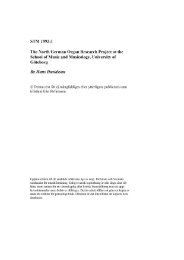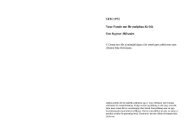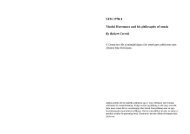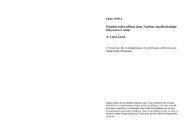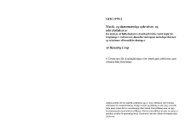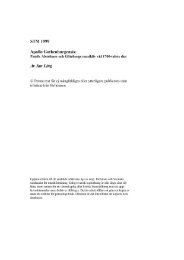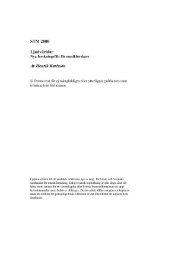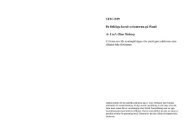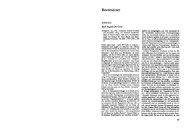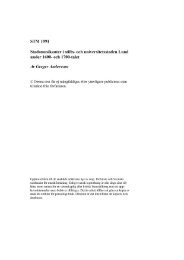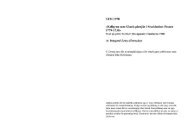Max Reger's Opus 135b and the Role of Karl Straube A study of the ...
Max Reger's Opus 135b and the Role of Karl Straube A study of the ...
Max Reger's Opus 135b and the Role of Karl Straube A study of the ...
Create successful ePaper yourself
Turn your PDF publications into a flip-book with our unique Google optimized e-Paper software.
STM 1994–95 <strong>Max</strong> Reger’s <strong>Opus</strong> <strong>135b</strong> <strong>and</strong> <strong>the</strong> <strong>Role</strong> <strong>of</strong> <strong>Karl</strong> <strong>Straube</strong> 105<br />
<strong>Max</strong> Reger’s <strong>Opus</strong> <strong>135b</strong> <strong>and</strong> <strong>the</strong> <strong>Role</strong> <strong>of</strong><br />
<strong>Karl</strong> <strong>Straube</strong><br />
A <strong>study</strong> <strong>of</strong> <strong>the</strong> intense friendship between a composer <strong>and</strong><br />
performer that had potentially dangerous consequences<br />
upon <strong>the</strong> genesis <strong>of</strong> Reger’s work<br />
Marcel Punt<br />
<strong>Max</strong> Reger’s “Fantasie und Fuge in d-moll, op. <strong>135b</strong>” for organ appears at a very crucial<br />
moment in <strong>the</strong> history <strong>of</strong> German music. Reger wrote this piece between 1914<br />
<strong>and</strong> 1916, a period in which tonality had to give way to o<strong>the</strong>r principles <strong>of</strong> composition,<br />
such as unity creating intervals, twelve-tone music, variable ostinato, tone colour-melodies,<br />
etc. With this piece, Reger st<strong>and</strong>s in <strong>the</strong> middle <strong>of</strong> this “development”<br />
from Wagner to Schönberg <strong>and</strong> Webern. So although <strong>the</strong> piece is still based on tonality,<br />
it already shows some aspects <strong>of</strong> <strong>the</strong> music that was to supersede it, namely both<br />
<strong>the</strong> fantasy <strong>and</strong> <strong>the</strong> fugue, which are based on <strong>the</strong> interval <strong>of</strong> a small second, <strong>the</strong> first<br />
<strong>the</strong>me <strong>of</strong> <strong>the</strong> fugue which consists <strong>of</strong> 11 different tones, <strong>the</strong> second which consists <strong>of</strong><br />
even 12 different tones, <strong>and</strong> Reger’s way <strong>of</strong> changing sound toge<strong>the</strong>r with <strong>the</strong> phrasing<br />
<strong>and</strong> <strong>the</strong> harmonic progress <strong>of</strong> <strong>the</strong> music. Reger’s opus <strong>135b</strong> for organ could be regarded<br />
as one <strong>of</strong> his most advanced <strong>and</strong> still deserves more attention than it has received<br />
to date.<br />
Most organists will still only know <strong>the</strong> piece in its definite shape, now available in<br />
<strong>the</strong> Peeters-edition. But <strong>the</strong> manuscript that was first sent to <strong>the</strong> editor Simrock in<br />
Berlin, differs quite substantially from <strong>the</strong> version that Simrock finally published.<br />
Not until 1966 did this manuscript become available in volume 18 <strong>of</strong> <strong>the</strong> “Gesamtausgabe”<br />
by H. Klotz, <strong>and</strong> <strong>the</strong> “Korrekturabzüge”, featuring final adjustments <strong>and</strong><br />
corrections, finally appeared in 1973. The latter pro<strong>of</strong>s show that all <strong>the</strong> corrections<br />
had been made in Reger’s own h<strong>and</strong>writing. The most radical concern <strong>the</strong> removal,<br />
<strong>and</strong> <strong>the</strong> adjustments this necessitated, <strong>of</strong> 10 bars from <strong>the</strong> fantasy, <strong>and</strong> 29 bars from<br />
<strong>the</strong> fugue.1<br />
Then <strong>the</strong> key question arose; which <strong>of</strong> <strong>the</strong> two versions should be played, when trying<br />
to convey Reger’s intentions? This problem was approached through <strong>the</strong> analysis<br />
1. See Appendix A.
106 Marcel Punt STM 1994–95<br />
<strong>of</strong> architecture, <strong>the</strong> analysis <strong>of</strong> <strong>the</strong> order <strong>of</strong> different keys in <strong>the</strong> fugue, <strong>and</strong> through<br />
quotations from <strong>the</strong> correspondence between Reger <strong>and</strong> musicians, friends, etc.2<br />
In 1987, Bengt Hambraeus added an important ingredient to <strong>the</strong> discourse. It is<br />
very likely that <strong>Karl</strong> <strong>Straube</strong>, one <strong>of</strong> Reger’s close friends <strong>and</strong> <strong>the</strong> performer <strong>of</strong> most<br />
<strong>of</strong> his organ-works, was actually responsible for many <strong>of</strong> <strong>the</strong> corrections executed by<br />
Reger.3 His hypo<strong>the</strong>sis arises in a much wider context <strong>of</strong> <strong>the</strong> aspect <strong>of</strong> interpretation<br />
in <strong>the</strong> performance practice at <strong>the</strong> beginning <strong>of</strong> this century, both in general <strong>and</strong> in<br />
<strong>the</strong> performance practice <strong>of</strong> <strong>Straube</strong> in particular. Therefore, this hypo<strong>the</strong>sis is presented<br />
more as a possible example <strong>of</strong> <strong>the</strong> way <strong>Straube</strong> interpreted <strong>and</strong> approached music,<br />
ra<strong>the</strong>r than as a main issue. But <strong>of</strong> potentially greater interest, is <strong>the</strong> extent <strong>of</strong> <strong>Straube</strong>’s<br />
influence on Reger’s life <strong>and</strong> music in general, <strong>and</strong> especially his involvement in <strong>the</strong><br />
development <strong>of</strong> <strong>135b</strong>.<br />
During <strong>the</strong>ir friendship, <strong>Straube</strong> was, at Reger’s request, involved in <strong>the</strong> compositional<br />
process <strong>of</strong> many pieces. He was asked to look for suitable texts for songs <strong>and</strong><br />
choir-music, <strong>and</strong> gave advice on technical difficulties concerning organ playing.<br />
From 1911, this influence increased strongly. Reger became more <strong>and</strong> more occupied<br />
with conducting <strong>and</strong> ensemble-playing, <strong>and</strong> was increasingly involved as a teacher<br />
at <strong>the</strong> conservatory in Leipzig. Because <strong>of</strong> this, he seldom had <strong>the</strong> opportunity to<br />
work out his sketches <strong>and</strong> to make fair copies <strong>of</strong> his compositions. During <strong>the</strong> time<br />
<strong>the</strong>y spent toge<strong>the</strong>r between 1911 <strong>and</strong> 1916, Reger discussed many <strong>of</strong> his rough outlines<br />
with <strong>Straube</strong>.4 Sometimes Reger even gave unfinished manuscripts to <strong>Straube</strong>,<br />
enabling him to have direct influence on <strong>the</strong> genesis <strong>of</strong> a piece.5<br />
2. a. O. Schreiber: “Zur Frage der gültigen Fassung von Regers Orgel-<strong>Opus</strong> <strong>135b</strong>”, Mitteilungen<br />
des <strong>Max</strong>-Reger-Instituts, Bonn, neunzehntes Heft, August 1973, pp. 34-38.<br />
b. M. Weyer: “Die Orgelwerke <strong>Max</strong> Regers”, Florian Noetzel Verlag, Wilhelmshaven<br />
1989, pp.129-134.<br />
3. B. Hambraeus: “<strong>Karl</strong> <strong>Straube</strong>, Old Masters <strong>and</strong> <strong>Max</strong> Reger”, Svensk Tidskrift för Musikforskning,<br />
Uppsala 1987, pp. 63-65.<br />
4. <strong>Straube</strong> thought that his cooperation in refining a composer’s outline was private between<br />
<strong>the</strong> two <strong>of</strong> <strong>the</strong>m, <strong>and</strong> that performers should only regard <strong>the</strong> edited piece as reliable. He<br />
wrote to Hans-Joachim Nösselt (24/04/1943): “Wenn Sie wüßten, wie <strong>of</strong>t ich, von meinem<br />
Freund <strong>Max</strong> Reger an, <strong>and</strong>eren Menschen diesen Dienst erwiesen habe, so würden<br />
Sie sehr erstaunt sein. Solches Tun geht fremde leute nichts an. Es ist eine Angelegenheit<br />
verschwiegener Art zwischen einzelnen Persönlichkeiten, die Außenwelt hat nur zu dem<br />
im Druck vorgelegten Werk als Ganzes Stellung zu nehmen.” (In: Briefe eines Thomaskantors).<br />
Cited from S. Popp: “<strong>Max</strong> Reger - Briefe an <strong>Karl</strong> <strong>Straube</strong>”, Ferd. Dümmlers Verlag, Bonn<br />
1986, p. 8.<br />
5. Popp, ibid., p. 213.
STM 1994–95 <strong>Max</strong> Reger’s <strong>Opus</strong> <strong>135b</strong> <strong>and</strong> <strong>the</strong> <strong>Role</strong> <strong>of</strong> <strong>Karl</strong> <strong>Straube</strong> 107<br />
But although in accordance with Reger’s wishes, <strong>Straube</strong>’s influence might still have<br />
damaged many <strong>of</strong> <strong>the</strong> innovative outlines. Having an unstable personality <strong>and</strong> lacking<br />
self-confidence, Reger was very easily influenced by <strong>the</strong> mentally strong <strong>Straube</strong>.<br />
Their lasting friendship started at <strong>the</strong> time when <strong>Straube</strong>, at <strong>the</strong> age <strong>of</strong> 25 <strong>and</strong> already<br />
a very successful performer, was <strong>the</strong> first to show interest in Reger’s pieces by<br />
playing <strong>the</strong>m at his recitals. Until <strong>the</strong>n, Reger’s earlier compositions had not received<br />
any critical acclaim, which lead to a huge personal crisis. Reger became lonely, a depressive<br />
<strong>and</strong> finally an alcoholic. The two met each o<strong>the</strong>r at one <strong>of</strong> <strong>Straube</strong>’s recitals<br />
<strong>and</strong> <strong>the</strong>y rapidly became close friends. Reger recovered his self-confidence through<br />
<strong>Straube</strong>’s increasing enthusiasm for his music6, <strong>and</strong> from <strong>the</strong>n on, he remained dependent<br />
on <strong>Straube</strong>, needing confirmation <strong>of</strong> his abilities as a composer for <strong>the</strong> rest <strong>of</strong><br />
his life.7<br />
With regards to <strong>135b</strong>, Reger repeatedly asked for this kind <strong>of</strong> appreciation from<br />
<strong>Straube</strong>. It took almost a year before <strong>Straube</strong> paid any attention to it, <strong>and</strong> on <strong>the</strong> 11th<br />
April 1916, having seen it for <strong>the</strong> first time, he immediately suggested <strong>the</strong> radical<br />
changes to <strong>the</strong> piece. The very next day <strong>the</strong> insecure Reger executed all <strong>of</strong> <strong>the</strong>se suggestions.8<br />
6. Popp, ibid., pp. 9-10.<br />
7. Concerning <strong>the</strong> Requiem, Reger’s wife Elsa wrote to <strong>the</strong>ir friends Fritz <strong>and</strong> Gretel Stein:<br />
“<strong>Straube</strong> hat ihm bewiesen, daß er dem St<strong>of</strong>f nicht gewachsen ist u. nun kann er es nicht<br />
fertig schreiben.... Wie <strong>of</strong>t - 5-6 Male weiß ich allein, hat <strong>Straube</strong> Werke von <strong>Max</strong> verworfen,<br />
die dann groß u. herrlich waren u. ihren Weg gingen. <strong>Straube</strong>s Einfluß ist nicht gut<br />
auf <strong>Max</strong>”. (16/12/1914)<br />
“<strong>Max</strong> wollte in deutscher Sprache ein Requiem schreiben... Er besprach dies leider mit<br />
<strong>Straube</strong> u. der riet ihm ab ; Es würde nur ein Abklatsch des Requiems von Brahms. Also<br />
nahm <strong>Max</strong> den lateinischen Text vor u. schuf u. schuf. Leider nahm er des öfteren sein<br />
Werk mit nach Leipzig u. sprach es mit St. durch; so auch heute vor 8 Tagen. St. erklärte<br />
ihm nun, er habe den lateinischen Text nicht ausgeschöpft, er werde des Textes nicht Herr.<br />
Natürlich entschuldigt St. sich immer bei <strong>Max</strong>, daß er ihm seine Meinung so <strong>of</strong>fen sagt,<br />
aber er sagt sie halt. Es ist <strong>Max</strong> der Glaube genommen ein Requiem schreiben zu können<br />
u. damit die Freude an dem Werk. Er findet den Faden nicht mehr u. hat das 3/4 fertige<br />
Werk St. geschenkt. Jetzt soll St. ihm einen deutschen Text aus der Bibel suchen. Lieber<br />
Fritz, <strong>Max</strong> is so unsagbar leicht zu beeinflussen u. steht z.Z. wieder ganz unter St. Bann....<br />
St. hat s.Z. mit dem Orgelwerk “Wie schön leuchtet der Morgenstern”, mit der “Serenade”,<br />
“Schlichten Weisen” etc. geirrt; er hat Lauterbach u.Kuhn vom Erwerb der Modulationslehre<br />
abgehalten, u. <strong>Max</strong> dadurch großen pekuniären Schaden zugefügt, das<br />
vergißt <strong>Max</strong> aber stets wieder u. hört in erster Linie auf St.”. (19/12/1914)<br />
Cited from Popp, ibid., pp. 245-246.<br />
8. For <strong>the</strong> complete survey <strong>of</strong> <strong>the</strong> letters from Reger to <strong>Straube</strong> concerning <strong>135b</strong>, see Appendix<br />
B.
108 Marcel Punt STM 1994–95<br />
It would appear to me, that in this case, a lot <strong>of</strong> damage has been done to <strong>the</strong> innovative<br />
version that Reger had in mind. During a year <strong>of</strong> correspondence before that<br />
particular evening, Reger had been expressing excitement in his letters to <strong>Straube</strong> over<br />
<strong>the</strong> length <strong>of</strong> <strong>the</strong> piece (see Appendix B). Obviously Reger had had no intention <strong>of</strong><br />
shortening <strong>the</strong> piece himself, although he was seeking <strong>Straube</strong>’s advice. What he really<br />
wanted was approval <strong>of</strong> his outline.<br />
Comparing both versions from an analytical perspective, <strong>the</strong> extent <strong>of</strong> <strong>the</strong> damage<br />
becomes clear. In <strong>the</strong> fantasy, repeated patterns such as <strong>the</strong> large scales ending with<br />
trills, have become loose fragments by cutting o<strong>the</strong>r places where <strong>the</strong>se patterns appear<br />
(see Appendix A 1). In <strong>the</strong> first fugue, <strong>the</strong> innovative acceler<strong>and</strong>o, which was achieved<br />
by <strong>the</strong> acceleration <strong>of</strong> <strong>the</strong> note-value, has disappeared (see Appendix A 2 – A 3), as it<br />
is, toge<strong>the</strong>r with <strong>the</strong> dynamic progress <strong>and</strong> phrasing, a very important part <strong>of</strong> <strong>the</strong> unity<br />
<strong>of</strong> this composition. All <strong>of</strong> <strong>the</strong>se parameters <strong>of</strong> Reger’s music are indispensable, because<br />
<strong>the</strong>y arose inseparably at <strong>the</strong> same time, belonging to one great idea.<br />
But just like <strong>the</strong> abridged version, <strong>the</strong> manuscript does not represent Reger’s intentions<br />
ei<strong>the</strong>r. Mostly Reger used <strong>the</strong> pro<strong>of</strong>s to refine his compositions, not only as a<br />
means <strong>of</strong> correcting <strong>the</strong> few mistakes that were reproduced by <strong>the</strong> editor, but also to<br />
improve <strong>the</strong> parts <strong>of</strong> <strong>the</strong> music with which he was no longer satisfied. He also did this<br />
with regards to <strong>135b</strong>. On <strong>the</strong> 1st March 1916, he wrote to <strong>Straube</strong> that he was looking<br />
through <strong>the</strong> pro<strong>of</strong> <strong>of</strong> this piece (see Appendix B 1). Because <strong>the</strong> printed pages that he<br />
cut out from <strong>135b</strong> have been thrown away, it is impossible to assess <strong>the</strong> extent <strong>of</strong> <strong>the</strong><br />
alterations. Therefore we can not rely on <strong>the</strong> manuscript ei<strong>the</strong>r to convey Reger’s intentions.9<br />
So <strong>the</strong> whole issue is even more complicated than had been assumed up until<br />
now. Now we are left with two versions, nei<strong>the</strong>r <strong>of</strong> which is au<strong>the</strong>ntic.<br />
9. To enable performers to decide Reger’s intentions for <strong>the</strong>mselves, it would be desirable to<br />
publish a faithful reproduction <strong>of</strong> <strong>the</strong> manuscript alongside <strong>the</strong> two latter pro<strong>of</strong>s. Any<br />
o<strong>the</strong>r attempt to publish this piece would inevitably become an interpretation, for which<br />
<strong>the</strong>re is no need. The publisher Breitkopf & Härtel did try to publish both versions in one<br />
sort <strong>of</strong> multifunctional text in volume 1 (nr. 8491) <strong>of</strong> <strong>the</strong> “Sämtliche Orgelwerke”, by<br />
printing <strong>the</strong> original version, from which organists, if <strong>the</strong>y would like to perform <strong>the</strong><br />
shortened version, could skip <strong>the</strong> parts that are between brackets. Apart from being an<br />
undesirable attempt to reproduce both versions, it would appear to me that this edition is<br />
nei<strong>the</strong>r practically, nor scientificly, very successful. The bars that have been changed by<br />
Reger to connect <strong>the</strong> parts that are left after <strong>the</strong> cuttings, are printed in <strong>the</strong> “Introduction”,<br />
which is very inconvenient. Even worse is <strong>the</strong> fact, that r<strong>and</strong>omly chosen elements<br />
concerning tempo indications, dynamic signs, phrasing <strong>and</strong> articulation from <strong>the</strong> shortened<br />
version, appear in <strong>the</strong> text <strong>of</strong> <strong>the</strong> original. How this work has been done, does not<br />
become clear in this edition. To discover this, according to <strong>the</strong> “Notes to <strong>the</strong> present edition”,<br />
one has to look at <strong>the</strong> critical notes in <strong>the</strong> volumes <strong>of</strong> <strong>the</strong> “Gesamtausgabe” edited<br />
by H. Klotz. So, apart from ano<strong>the</strong>r inconvenience, <strong>the</strong> edition in itself also fails scientificly.
STM 1994–95 <strong>Max</strong> Reger’s <strong>Opus</strong> <strong>135b</strong> <strong>and</strong> <strong>the</strong> <strong>Role</strong> <strong>of</strong> <strong>Karl</strong> <strong>Straube</strong> 109<br />
In particular being a composer, conductor <strong>and</strong> pianist, Reger was probably not very<br />
familiar with <strong>the</strong> “in-crowd” <strong>of</strong> organists. From 1915, <strong>Straube</strong> became increasingly involved<br />
in what was later to become <strong>the</strong> “Orgelbewegung”, which spearheaded <strong>the</strong> revival<br />
<strong>of</strong> baroque music, as well as <strong>the</strong> integration <strong>of</strong> some elements <strong>of</strong> baroque style<br />
into contemporary composing. He became progressively critical <strong>of</strong> Reger’s still Wagnerian<br />
alternations <strong>of</strong> extreme emotion, culminating in complete rejection <strong>of</strong> <strong>the</strong> whole<br />
style10, although Reger seemingly did not notice. In his letters to <strong>Straube</strong>, Reger<br />
kept expressing excitement about his latest piece (“...was recht schönes...”), <strong>and</strong> assumed<br />
<strong>Straube</strong> to have great interest in it (see Appendix B 2).<br />
However, outside this in-crowd <strong>of</strong> organists Reger received a lot <strong>of</strong> critical acclaim,<br />
<strong>and</strong> was held in high esteem by <strong>the</strong> general public, o<strong>the</strong>r musicians, <strong>and</strong> composers<br />
like Schönberg <strong>and</strong> Webern. Between 1918 <strong>and</strong> 1922, 34 compositions <strong>of</strong> Reger have<br />
been performed in Vienna at <strong>the</strong> Society for Private Musical Performances, which was<br />
administrated by <strong>the</strong>se composers during that time. (Debussy had 26 <strong>of</strong> his pieces performed<br />
<strong>the</strong>re, Bartok <strong>and</strong> Ravel 12 each, <strong>and</strong> Scriabin 11.)11<br />
The whole story comes to a sad end. <strong>Straube</strong> received <strong>the</strong> finally finished third pro<strong>of</strong><br />
as an “Easter-greeting”, <strong>the</strong> intention being that he should perform <strong>the</strong> premiere. However,<br />
<strong>Straube</strong> never expressed appreciation towards Reger for this “honour”, <strong>and</strong> in<br />
fact completely disassociated himself from <strong>the</strong> whole issue.12<br />
Seeing <strong>the</strong> final result, did he perhaps finally realize that <strong>the</strong>re was no meaning in<br />
trying to adapt a piece which is constructed within its own style, to <strong>the</strong> new ideals <strong>of</strong><br />
<strong>the</strong> “Orgelbewegung”? Did he realize that his interference had in fact been destructive<br />
to <strong>the</strong> piece, <strong>and</strong> feel embarrassed about it? Does this explain his lack <strong>of</strong> reaction to<br />
Reger’s last three letters in which he had repeatedly requested a meeting on <strong>the</strong> 10th<br />
May 1916 at <strong>the</strong>ir pub “Hannes” (see Appendix B 2)?<br />
On <strong>the</strong> very night that <strong>the</strong> two were supposed to meet, Reger died <strong>of</strong> a heart attack<br />
in his hotel room in Leipzig.13<br />
10. Popp, ibid., p. 16.<br />
11. H. Moldenhauer: “Anton Webern. A Chronicle <strong>of</strong> his Life <strong>and</strong> Work”, London 1978, p.<br />
228.<br />
Cited from Hambraeus, ibid, p. 54.<br />
12. Instead <strong>of</strong> <strong>Straube</strong>, <strong>the</strong> premiere was performed by H. Dettmer on <strong>the</strong> 11th June 1916.<br />
Cited from Popp, ibid., p. 260.<br />
13. Popp, ibid., p. 260
110 Marcel Punt STM 1994–95<br />
Appendix A 1 – Removed sections from <strong>135b</strong>
STM 1994–95 <strong>Max</strong> Reger’s <strong>Opus</strong> <strong>135b</strong> <strong>and</strong> <strong>the</strong> <strong>Role</strong> <strong>of</strong> <strong>Karl</strong> <strong>Straube</strong> 111<br />
Appendix A 2 – Removed sections from <strong>135b</strong>
112 Marcel Punt STM 1994–95<br />
Appendix A 3– Removed sections from <strong>135b</strong>
STM 1994–95 <strong>Max</strong> Reger’s <strong>Opus</strong> <strong>135b</strong> <strong>and</strong> <strong>the</strong> <strong>Role</strong> <strong>of</strong> <strong>Karl</strong> <strong>Straube</strong> 113<br />
Appendix A 4– Removed sections from <strong>135b</strong>
114 Marcel Punt STM 1994–95<br />
Appendix B – Survey <strong>of</strong> <strong>the</strong> letters from Reger to <strong>Straube</strong> concerning <strong>135b</strong><br />
date<br />
end <strong>of</strong> september<br />
1914<br />
quotations from correspondence between<br />
Reger <strong>and</strong> <strong>Straube</strong> 1<br />
”Nun wegen des Orgelwerks: so will ich Dir gestehen,<br />
daß ich ein solches vorhabe! Ich gehe<br />
schon etwas ”schwanger” mit der Sache! Also<br />
wird sie wohl werden!”<br />
remarks<br />
This seems to be an answer to<br />
a request from <strong>Straube</strong>. They<br />
may have spoken about it previously.<br />
29/10/14 ”Ein neues großes Orgelwerk ”kristallisiert”<br />
sich.”<br />
30/04/15 ”Es interessiert Dich wohl zu vernehmen, daß ich<br />
an einem neuen Orgelwerk großen Stils arbeite!<br />
Kann ich nächsten Donnerstag 6. Mai abends 7<br />
1/2 Uhr ”ungegessen” zu euch kommen? Bitte<br />
um möglichst umgehendste Nachricht!”<br />
On <strong>the</strong> 3rd May 1915, Reger<br />
repeats this request very<br />
strongly.<br />
05/05/15 ”Deine 2 Karten erhalten, haben sich mit meiner<br />
gekreuzt! Ich komme morgen Donnerstag sehr<br />
pünktlich abends 7.30 zu Euch; ...”<br />
17/05/15 Reger mentions <strong>the</strong> piece in<br />
a letter to Simrock (”ein<br />
Orgelwerk größten Stils -<br />
aber nicht zu lang....”), <strong>and</strong><br />
asks for <strong>the</strong> transfer <strong>of</strong> 1000<br />
Marks to his account, as had<br />
been arranged. 2 It was probably<br />
at this time that Reger<br />
sent <strong>the</strong> manuscript to Simrock.<br />
01/03/16 ”Es war doch fein, daß wir uns gestern Abend<br />
getr<strong>of</strong>fen haben! Ich sehe soeben die Korrekturbogen<br />
durch von meinem op. <strong>135b</strong>: Phantasie<br />
und Fuge (d-moll) für Orgel! Ein neues<br />
großes Orgelwerk! Ich h<strong>of</strong>fe sehr, Dir dasselbe<br />
im April dann geben zu können gedruckt. Es<br />
hat 20 Druckseiten Umfang.”<br />
07/04/16 ”…, ich bringe ein neues, großes Orgelwerk<br />
mit.”<br />
Reger still mentions <strong>the</strong> full<br />
title. He also writes that it<br />
concerns a ”new major<br />
piece for organ”. So <strong>Straube</strong><br />
has yet to see it.<br />
He underlines <strong>the</strong> word<br />
”gedruckt” (printed), because<br />
<strong>of</strong>ten <strong>Straube</strong> received a<br />
second copy <strong>of</strong> <strong>the</strong> manuscript<br />
from Reger. 3<br />
The ”Korrekturbogen” concern<br />
<strong>the</strong> second pro<strong>of</strong>. 4<br />
Obviously <strong>Straube</strong> still has<br />
not seen <strong>the</strong> piece.
STM 1994–95 <strong>Max</strong> Reger’s <strong>Opus</strong> <strong>135b</strong> <strong>and</strong> <strong>the</strong> <strong>Role</strong> <strong>of</strong> <strong>Karl</strong> <strong>Straube</strong> 115<br />
date<br />
quotations from correspondence between<br />
Reger <strong>and</strong> <strong>Straube</strong> 1<br />
remarks<br />
10/04/16 ”Kann ich nun nächsten Dienstag 11. April<br />
(morgen) abends 1/2 8 Uhr (7 1/2) zu Euch<br />
kommen oder wo wollen wir uns sonst nächsten<br />
Dienstag abend treffen? ...Das neue Orgelwerk<br />
bringe ich mit!”<br />
12/04/16 ”Die Änderungen in dem Orgelwerk hab’ ich<br />
schon alle gemacht! Ich sende es morgen nach<br />
Berlin und lasse Dir sobald als möglich einen<br />
exemplarmäßigen Abzug machen! Ich denke,<br />
daß ich Dir denselben balde senden kann. Es<br />
war doch fein, daß wir uns gestern abend getr<strong>of</strong>fen<br />
haben.”<br />
22/04/16 ”Ich sende Dir anbei als Ostergruß das neue<br />
Orgelwerk, das ich extra für Dich in exemplarmäßigem<br />
Abzug habe herstellen lassen! Es<br />
kommt also noch so früh, daß Du das Werk in<br />
Hannover ”uraufführen” kannst; denn technische<br />
Schwierigkeiten wird Dir das Ding ja<br />
nicht bieten!<br />
Nun höre: ich bin am 10. Mai Mittwoch<br />
abends in Leipzig, übernachte sogar in Leipzig,<br />
bitte, richte Du Dir das sicher so ein, daß<br />
wir uns am 10. Mai abends treffen! Wenn Du<br />
Chorprobe hast, so treffen wir uns eben nach<br />
Deiner Chorprobe; ich schlage wie immer<br />
”Hannes” vor! Also sei so gut, darauf nicht zu<br />
vergessen! Bitte, sei so gut, mir wegen unseres<br />
Zusammentreffens am 10. Mai abends, auf das<br />
ich mich sehr freue, genaueste Nachricht baldigst<br />
zukommen zu lassen.”<br />
08/05/16 ”Vergiß Du bitte nicht, daß wir uns nächsten<br />
Mittwoch 10. Mai, abends bei Hannes treffen<br />
wollen. Du kommst nach Deiner Probe; ich<br />
bin um 10 Uhr abends sicher bei Hannes! Ich<br />
bringe Dir was sehr Schönes mit! Also sei so<br />
gut, sicher abends 10 Uhr am Mittwoch 10. Mai<br />
abends im Hannes zu sein!”<br />
09/05/16 ”Nicht wahr, Du vergißt nicht darauf, daß wir<br />
uns für morgen, Mittwoch 10. Mai abends bei<br />
Hannes verabredet haben! Du kommst, bitte,<br />
sogleich nach Deiner Probe zu Hannes! Ich bin<br />
von 10 Uhr abends an sicher bei Hannes. Sollte<br />
ich noch nicht da sein, so komme ich s<strong>of</strong>ort<br />
dann! Ich bringe Dir auch was recht Schönes<br />
mit.”<br />
On <strong>the</strong> 11th April 1916,<br />
having seen it for <strong>the</strong> first<br />
time, <strong>Straube</strong> immediately<br />
suggested <strong>the</strong> radical alterations<br />
in <strong>the</strong> piece.<br />
The ”exemplarmäßige<br />
Abzug” concerns <strong>the</strong> third<br />
pro<strong>of</strong> (see note 4, pp. 116).<br />
Obviously <strong>Straube</strong> never<br />
expressed any appreciation<br />
for <strong>Reger's</strong> alterations, even<br />
though it was done at his<br />
request, <strong>and</strong> did not even<br />
reply to <strong>the</strong> three letters in<br />
which Reger repeatedly<br />
asked him to come <strong>and</strong> see<br />
"something really beautiful".
116 Marcel Punt STM 1994–95<br />
Notes to Appendix B<br />
1. Popp, ibid., pp. 242-260.<br />
2. Weyer, ibid. p. 124.<br />
3. Popp, ibid., “Einleitung”.<br />
4. Reger executed <strong>the</strong>se cuttings in <strong>the</strong> assumed first pro<strong>of</strong>. But this pro<strong>of</strong> is actually <strong>the</strong> second. According<br />
to O. Schreiber (see note 2a, p. 2), it shows on <strong>the</strong> reverse <strong>of</strong> <strong>the</strong> last page, a stamp <strong>of</strong> <strong>the</strong> editor<br />
which says “II. Correctur”, <strong>and</strong> on <strong>the</strong> front page a stamp <strong>of</strong> <strong>the</strong> “Notenstecherei C.G. Röder” with <strong>the</strong><br />
date “15. Jan. 1916”. Reger had probably sent <strong>the</strong> manuscript to Simrock on <strong>the</strong> 17th May 1915 (see<br />
remark 17/05/15 in <strong>the</strong> table). It would appear to me that an editor does not need 8 months, from May<br />
1915 till January 1916, to make a pro<strong>of</strong>. Finally, <strong>the</strong>re are also some differences between <strong>the</strong> manuscript<br />
<strong>and</strong> <strong>the</strong> printed text <strong>of</strong> this assumed first pro<strong>of</strong>, obviously not mistakes, which means that <strong>the</strong>re must<br />
have been a previous pro<strong>of</strong>, which has probably been lost. The third pro<strong>of</strong> was made between <strong>the</strong> 12th<br />
<strong>and</strong> 22nd April 1916 especially for <strong>Straube</strong>, so that he could perform <strong>the</strong> premiere.
STM 1994–95 <strong>Max</strong> Reger’s <strong>Opus</strong> <strong>135b</strong> <strong>and</strong> <strong>the</strong> <strong>Role</strong> <strong>of</strong> <strong>Karl</strong> <strong>Straube</strong> 117<br />
Bibliography<br />
Hambraeus, Bengt: <strong>Karl</strong> <strong>Straube</strong>, Old Masters <strong>and</strong> <strong>Max</strong> Reger, A Study in 20th Century<br />
Performance Practice, Svensk Tidskrift för Musikforskning, Uppsala 1987,<br />
pp. 37-73.<br />
Popp, Susanne: <strong>Max</strong> Reger - Briefe an <strong>Karl</strong> <strong>Straube</strong>, Veröffentlichungen des <strong>Max</strong>-Reger-Institutes,<br />
Elsa-Reger-Stiftung, Zehnter B<strong>and</strong>, Ferd. Dümmlers Verlag,<br />
Bonn 1986.<br />
Schreiber, Ottmar: Zur Frage Der Gültigen Fassung von Regers Orgel-<strong>Opus</strong> <strong>135b</strong>,<br />
Mitteilungen des <strong>Max</strong>-Reger-Instituts, Bonn, Neunzehntes Heft, August 1973,<br />
pp. 34-38.<br />
Weyer, Martin: Die Orgelwerke <strong>Max</strong> Regers, Ein H<strong>and</strong>buch für Organisten, Taschenbücher<br />
zur Musikwissenschaft, Florian Noetzel Verlag, Wilhelmshaven<br />
1989, pp. 123-134.<br />
Acknowledgements<br />
This <strong>study</strong> has been written within <strong>the</strong> Performer’s Study Programme with Musicology<br />
at <strong>the</strong> School <strong>of</strong> Music <strong>and</strong> Musicology, Göteborg University, Sweden.<br />
I would like to express my gratitude to <strong>the</strong> following for <strong>the</strong>ir help with this article:<br />
- Musikhögskolan vid Göteborgs Universitet<br />
- <strong>Max</strong>-Reger-Institut, Bonn, <strong>and</strong> in Particular Dr. S. Popp<br />
- Bayerische Staatsbiblio<strong>the</strong>k, München.<br />
Finally, I would like to thank Charles Money, for his extensive help with refining <strong>the</strong><br />
English text <strong>and</strong> for his assistance with pro<strong>of</strong>-reading.
118 Marcel Punt STM 1994–95



